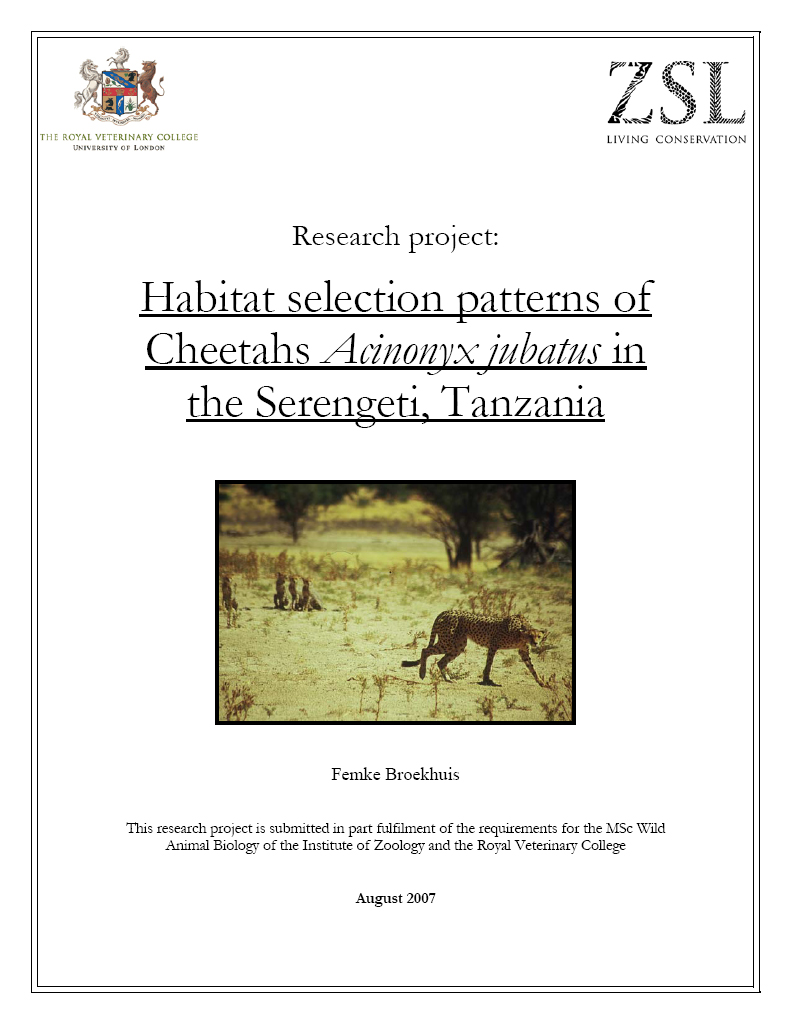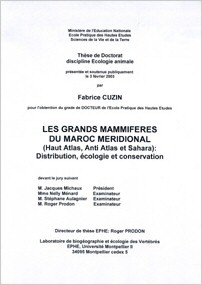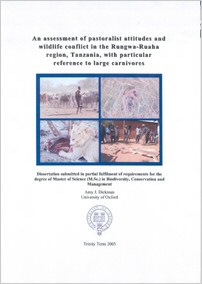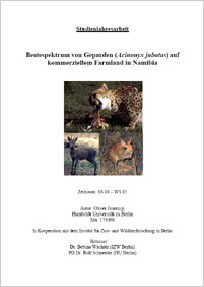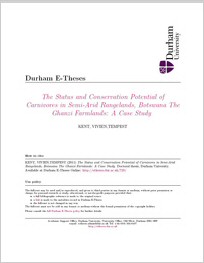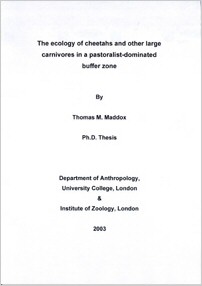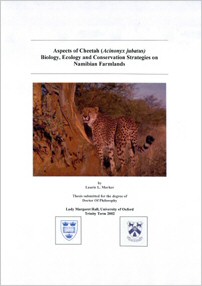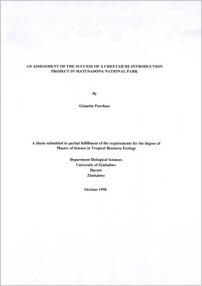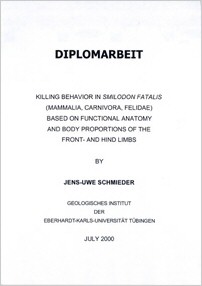|
|
Mubalama Kakira L. 2010. Monitoring law enforcement effort and illegal activity in selected protected areas: Implications for managment and conservation, Democratic Republic of Congo. Poaching remains a sensitive and controversial issue, especially amidst a diversity of combined political upheaval and economic turmoil when biodiversity is being lost at an accelerated rate resulting in some of charismatic species becoming plummeted amidst the wave of illegal offtake caused by a number of factors acting in concert. The thesis highlights practical issues which must be addressed to improve the effectiveness of conservation strategies. MSc Thesis, University of Ghent, 418 pp. |
|
|
|
|
|
Broekhuis F. 2007 Habitat selection patterns of cheetahs Acinonyx jubatus in the Serengeti, Tanzania
The Serengeti Cheetah Project in Tanzania has collected a substantial amount of uninterrupted tracking data, providing the perfect opportunity to test whether initial sightings are indeed characteristic of the habitat that is selected.
M.Sc., University of London 47 pp. Broekhuis_2007_Cheetah_habitat_selection_in_the_Serengeti.pdf |
|
|
|
|
|
Bissett C. 2005 The feeding ecology, habitat selection and hunting behaviour of re-introduced cheetah on Kwandwe Private Game Reserve, Eastern Cape Province
The re-introduction of cheetah onto small reserves in the Eastern Cape Province has created the opportunity to study this species in an environment (Valley Bushveld) in which it has not previously been studied. Thus the aim of this study is to add to the studies of cheetah in more wooded habitats and to contribute a better understanding of the level of specialization or adaptability in space use, habitat selection, diet and hunting behaviour that the cheetah possesses.
M.Sc., Rhodes University, South Africa 166 pp. |
|
|
|
|
|
Cuzin F. 2003. Les grands mammifères du Maroc méridonial (Haut Atlas, Anti Atlas et Sahara): Distribution, écologie et conservation (Large mammals of southern Morocco (High Atlas, Anti Atlas and Sahara): Distribution, ecology and conservation).
A study from bibliography and observational data (2181 observations including locality, altitude, climate and vegetation) was made on 29 species of large mammals that have been found in the 20th century in Morocco from the Atlas Mountains to the Sahara. The cheetah's population in Morocco seems not to exceed 20 individuals and is probably located along mined Saharan defence walls.
PhD, Laboratoire de biogéographie et écologie des Vertébrés, Ecole Pratique des Hautes Etudes, Université Montpellier II 347 pp. |
|
|
|
|
|
Dickman A.J. 2005 An assessment of pastoralist attitudes and wildlife conflict Rungwa in the Rungwa-Ruaha region region, Tanzania , with particular reference to large carnivores
Human-wildlife conflict is an issue of pressing conservation concern, particularly when it involves threatened species, and accurately identifying the causes of such conflict is fundamental to developing effective resolution strategies. This study investigated attitudes of Maasai and Barabaig pastoralists towards wildlife in central Tanzania, with particular emphasis on five focal carnivore species, including cheetahs.Pastoralists reported significant problems with wild animals, particularly carnivores, and results suggested that low levels of retaliatory killing were predominantly due to circumstantial constraints rather than innate tolerance.
M.Sc., University of Oxford, UK 95 pp. Dickman_2005_Pastoralist_attitudes_towards_large_carnivores_in_Tanzania.pdf |
|
|
|
|
|
Gharaibeh, B. M. 1997. Systematics, distribution, and zoogeography of mammals of Tunisia.
PhD
Thesis, Texax Tech University, USA |
|
|
|
|
|
Heim
de Balsac H. 1936
PhD
Thesis, University of Paris |
|
|
|
|
|
Jauernig O. 2005.
Humboldt-Universität
zu Berlin |
|
|
|
|
|
Kent, V. T. 2011.
|
|
|
|
|
|
Maddox T. M. 2003 |
|
|
|
|
|
Marker L. L. 2002 Aspects of Cheetah (Acinonyx jubatus) Biology, Ecology, Conservation Strategies on Namibian Farmland
In an increasingly human-dominated environment, the task of successfully conserving large carnivores, such as cheetahs, is difficult due to real or perceived threats resulting in conflict and often their local extirpation. This research describes the causes and potential solutions to this conflict in Namibia. Cheetah biology and ecology were studied through physical examination, laboratory analysis, radio-tracking and human perceptions using survey techniques. Between 1991 and 2000 data were collected on over 400 live-captured and dead cheetahs.
PhD, Universtiy of Oxford, UK 516 pp. |
|
|
|
|
|
Purchase
G.K 1998
MSc
Thesis, Department of Biological Sciences, University
of Zimbabwe, Harare, Zimbabwe, 127 pp. |
|
|
|
|
|
Schmieder
J.-U. 2000
Elongated
canines exclusively evolved in carnivores, which are
able to stabilize their victims with their anterior
extremities. It was shown that power and agility of
the front limbs are strongly correlated with the development
of sabers. Limb- and skull proportions of the extinct
cat Smilodon fatalis were therefore compared
with those of six extant species of large felids and
those of Canis lupus. The
lightly built Acinonyx jubatus is found exclusively
in low structured habitats, consequently it has the
relatively longest limbs of all large felids, the smallest
angle of inclination of the olecranon fossa and an insertion
of the T. major closer to the joint. Its prey usually
weighs less than its own body weight. |
|
|
|
|
|
Schueling
K. 1990
A number of different possibilities and methodological procedures of this research project are discussed to improve the situation of cheetahs in captivity. These are: change of feeding rhythms, use of a feeding apparatus, creation of neighbouring ungulate enclosures and the extension of the times the animals are spending in their outside enclosures.
MSc
Thesis, Westfälische Wilhelms-Universität Münster Schueling_1990_Behaviour_of_cheetah_in_captivity_under_different_conditions_2.pdf |
|
|
|
|
|
|
|
|
|
|
|
|
